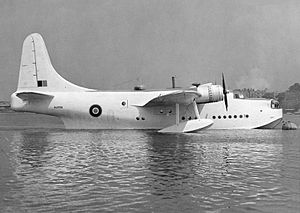Short Seaford
| S.45 Seaford | |
|---|---|

| |
| Seaford NJ205 at Rochester, July 1946 | |
| Role | Flying boat |
| National origin | United Kingdom |
| Manufacturer | Short Brothers |
| First flight | 30 August 1944 |
| Primary user | Royal Air Force |
| Number built | 10 |
| Developed from | Short Sunderland |
| Variants | Short Solent |
The Short S.45 Seaford was a 1940s flying boat, designed as a long range maritime patrol bomber for RAF Coastal Command. It was developed from the
Short S.25 Sunderland
, and initially ordered as "Sunderland Mark IV".
Background
In 1942, the Air Ministry issued
Specification R.8/42 for a replacement of the Sunderland, as a long range patrol bomber for service in the Pacific Ocean. It required more powerful engines, better defensive armament, and other enhancements.[1][2]
Design and development
The Sunderland Mark IV used major structural elements of the Sunderland Mark III, with a fuselage stretch of 3 ft ahead of the wing, an extended and redesigned planing bottom, the same wing with thicker Duralumin skinning, and
Bristol B.17 dorsal turret, twin .50 in (12.7 mm) guns in a Glenn-Martin tail turret, and another .50 in (12.7 mm) machine gun in a hand-held waist position on each side of the fuselage. The turrets were all electrically powered. Two prototypes and thirty production aircraft were ordered as the Sunderland Mark IV.[1][2]
Operational history

On 30 August 1944, the prototype (MZ269) first flew from the
BOAC as G-AGWU, then returned to MAEE as NJ201 in February 1946. In April 1946, the other six production Seafords were delivered to No. 201 Squadron RAF for brief operational trials. In 1948, those six aircraft were modified as civilian airliners at Belfast, then leased to BOAC with the designation Solent 3.[5]
Operators
Specifications (S.45 Seaford)
Data from Green 1968, p. 107[6]
General characteristics
- Crew: 8–11 (two pilots, radio operator, navigator, engineer, bomb-aimer, three to five gunners)
- Length: 88 ft 6+3⁄4 in (26.994 m)
- Wingspan: 112 ft 9+1⁄2 in (34.379 m)
- Height: 37 ft 3 in (11.35 m)
- Wing area: 1,687 sq ft (156.7 m2)
- Empty weight: 45,000 lb (20,412 kg)
- Gross weight: 75,000 lb (34,019 kg)
- Powerplant: 4 × Bristol Hercules XIX 14-cylinder radial engines, 1,720 hp (1,280 kW) each
Performance
- Maximum speed: 242 mph (389 km/h, 210 kn) at 500 ft (150 m)
- Cruise speed: 155 mph (249 km/h, 135 kn) at 5,000 ft (1,500 m)
- Range: 3,100 mi (5,000 km, 2,700 nmi) [7][8]
- Service ceiling: 14,000 ft (4,300 m)
- Rate of climb: 880 ft/min (4.5 m/s)
- Time to altitude: 18 min to 10,000 ft (3,000 m)
Armament
- Guns: 6 × Browning machine guns (two each in nose and tail turrets and two beam guns), 2 x 20 mm Hispano cannon in dorsal turret and 2 × fixed .303 in Browning machine gun
- Bombs: 4,960 lb (2,250 kg) of bombs and depth charges
Survivor
Short S.45 Seaford NJ203, converted to a Short Solent in 1948, is displayed at the Oakland Aviation Museum, Oakland, California.[9][10]
See also
Aircraft of comparable role, configuration, and era
Related lists
Notes
- ^ a b Barnes 1989, pp. 357
- ^ a b Green 1968, p. 106.
- ^ Barnes 1967, p. 360.
- ^ London 2003, p. 196.
- ^ Barnes 1989, pp. 360–363
- ^ Green 1968, p. 107.
- ^ Barnes 1967, p. 368.
- ^ London 2003, pp. 264–265.
- ^ Ogden (2007)
- ^ ""Short Solent"". Archived from the original on 19 June 2016. Retrieved 14 March 2015.
Bibliography
- Barnes, C.H. Shorts Aircraft since 1900. Putnam, 1967, 1989 ISBN 0-85177-819-4
- Green, William. War Planes of the Second World War: Volume Five Flying Boats. Macdonald, 1968. ISBN 0-356-01449-5.
- London, Peter. British Flying Boats. Sutton Publishing, 2003. ISBN 0-7509-2695-3.
- Ogden, Bob (2007). Aviation Museums and Collections of North America. Air-Britain. ISBN 0-85130-385-4
- Warner, Guy (July–August 2002). "From Bombay to Bombardier: Aircraft Production at Sydenham, Part One". ISSN 0143-5450.
External links
Wikimedia Commons has media related to Short Seaford.
- Short Seaford Flight 3 January 1946 (3 pages of diagrams and images)
